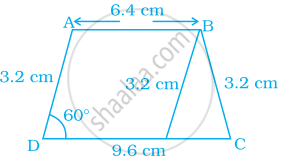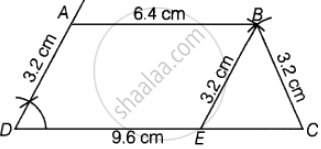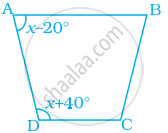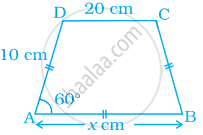Advertisements
Advertisements
Question
Construct a trapezium ABCD where AB || CD, AD = BC = 3.2 cm, AB = 6.4 cm and CD = 9.6 cm. Measure ∠B and ∠A.

[Hint: Difference of two parallel sides gives an equilateral triangle.]
Solution

Steps of construction:
Step I: Draw a line segment DC = 9.6 cm.
Step II: With D as centre, draw an angle measure 60°. Now, cut-off it with an arc 3.2 cm called point A.
Step III: Now, draw a parallel AB || CD.
Step IV: Talking C as centre, cut an arc B measure 3.2 cm on previous parallel line.
Step V: Draw a line segment BE = 3.2 cm from arc B.
Step VI: Join B to E and C.
Hence, ABCD is a required trapezium where ∠A = 120° and ∠B = 60°.
APPEARS IN
RELATED QUESTIONS
All parallelograms are trapeziums.
All squares are trapeziums.
In `square` IJKL, side IJ || side KL, ∠I = 108°, ∠K = 53° then find the measure of ∠J and ∠L.
Which of the following figures do not satisfy any of the following properties?
- All sides are equal.
- All angles are right angles.
- Opposite sides are parallel.
PQRS is a trapezium in which PQ || SR and ∠P = 130°, ∠Q = 110°. Then ∠R is equal to ______.
A quadrilateral in which a pair of opposite sides is parallel is ______.
Every rhombus is a trapezium.
Find the value of x in the trapezium ABCD given below.

In the following figure, AB || DC and AD = BC. Find the value of x.

Construct a trapezium ABCD in which AB || DC, ∠A = 105°, AD = 3 cm, AB = 4 cm and CD = 8 cm.
